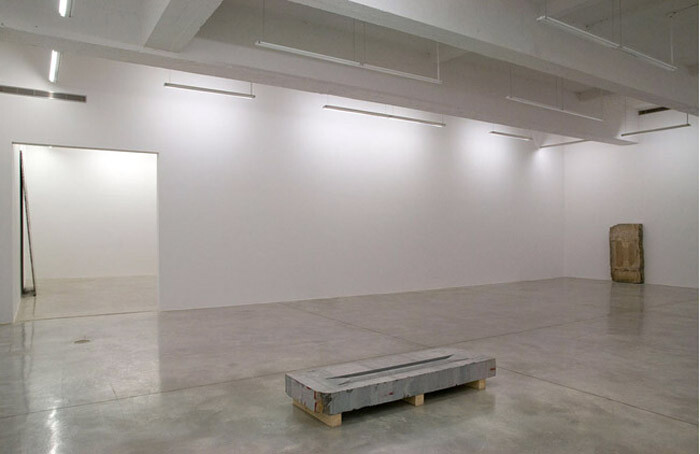Is a lot of empty space and a couple of big slabs of marble enough to unify an exhibition? Almost certainly yes, which is also the problem: it’s too easy to make a show look cohesive when there’s not much in it. For her fourth solo show at Casey Kaplan, Trisha Donnelly sparsely arranged a few stone sculptures—relics from the fourth (and relatively empty) dimension.
In the first gallery, front and center, there’s an angular pink stone with two ridged scooped out areas on either side. Mounted on two 2x4s, it resembled a seashell, temporarily beached here. In the following room is what looks like a fossil or victim of some mechanical penetration, the scars of the brutal equipment meant to harvest unnamed riches laid bare. When the show was first installed, a small amount of water left from the wetted blades used to cut the stone lay suggestively in the stone’s cracks. (I was disappointed when the gallery director Loring Randolph told me there was no intended meaning behind this; the water was gone when I returned.)
One of many possible Rosetta Stones to the show, a yellowish slab of marble leaning against the far wall with two loud speaker-esque slits carved into its face and the sound of jingle bells mired by static seemed to impart some mysterious Morse code. In the back room, the only hand-chiseled monolith in the show resembled an incomplete thought the artist had scribbled on a torn-out notebook page; it was paired here with a small picture of an unidentified body of water, which evoked notions of both captured and continuous time. The mystery was enough to sustain interest.
Attempting to help clear up some of the more oblique aspects of the exhibition, the director explained to me that all of the stones are connected to Donnelly’s earlier work (though no gallery would dare say anything to the contrary—collectors don’t love change). In the sense that Donnelly’s exhibition seems largely a result of an intuitive practice, ergo, the sense or nonsense of it all is not necessarily connected to its truth. Her 2007 solo show at Kaplan was comprised of a variety of legible objects, tree branches, abstract graphite drawings, objects wrapped in fabric, and photographs often picturing other wrapped things. Critics at Time Out, Artforum, and The New York Times called that show enigmatic too. Mystery, apparently, is her modus operandi.
The overall effect of her seemingly elliptical efforts in this exhibition is positive, but for one instance whereby Donnelly’s pleasant unknowns are transformed into bewilderment. This comes in the form of what looks to be a found object opposite the gallery’s front desk. An early 20th century kidney-shaped desk made of wood, titled The Secretary (2010), the piece connects so obliquely to the rest of the show I originally thought it was the work of a different artist. The disjunction is intentional of course–Donnelly sees the work as the brain or control center for the show and has separated it for this reason–but unless the viewer knows she’s made similarly conceived control centers in the past, it’s impossible to understand the desk’s purpose. In a way, its inclusion addresses the problems implicit in putting together a show so consistent in material and arrangement that it almost resolves itself too easily. It’s a logical solution, but ultimately leaves open the question of why.



